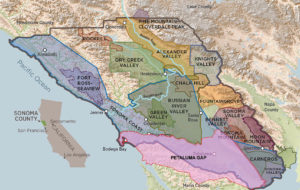THE BLUSTERY DETAILS OF THE PETALUMA GAP, AMERICA’S NEWEST AVA
by Christopher Sawyer
THIS PAST DECEMBER, vintners and growers attending the annual Petaluma Gap Winegrowers Alliance (PGWA) holiday party in Sonoma County finally received the present that had topped their lists for the past three years. 
Earlier that day, the Alcohol and Tobacco Tax and Trade Bureau (TTB) announced its official ruling recognizing the Petaluma Gap as the newest American Viticultural Area (AVA). Located 25 miles north of the Golden Gate Bridge, this freshly-crowned appellation roots itself around the historic city of Petaluma.
With a surface area of 200,000 acres, the appellation encompasses the southwestern segment of Sonoma County and a small portion of northern Marin County. Of the 4,000 acres planted, three-quarters of the vineyards are dedicated to Pinot Noir, with the remainder primarily planted to Chardonnay and Syrah.
Stretching from Bodega Head to Tomales Bay on the coast to the west-facing slopes of Sonoma Mountain to the east, the beautiful rural landscape features a patchwork of clay, sandstone, and alluvial-based soils. In addition to its warm daytime temperatures, the characteristics that ultimately set this AVA apart from the other cool-climate subzones in Sonoma County include the strong influence of maritime breezes, as well as a dense afternoon fog that blows in unabated toward the vineyards during the growing season.
This “wind tunnel” effect causes the grape clusters to ripen slowly, producing thick-skinned berries with structure, bountifully-complex flavors, lower levels of sugar, and abundant natural acidity. For these reasons, the running theme used by the vintners and growers working with fruit from the Petaluma Gap is “wind to wine.”
The AVA currently includes nine wineries and 80 winegrowers—many of whom sell fruit to wineries throughout northern California. In addition to the boutique vineyard–sourced grapes commonly used in blends or small-lot bottlings, the region is also home to an impressive list of vineyard-designate wines from unique sites that include Gap’s Crown, Keller Estate, Sangiacomo Vineyards, Griffin’s Lair, Blue Wing Vineyard, Terra de Promissio, Rockin’ H Ranch, Clary Ranch, Armagh Vineyard, and Devil’s Gulch Ranch.
Along with notable producers regularly working with fruit from the region—among them Kosta Browne, Wind Gap, Roger Roessler, Flowers, Cline, Pellet Estate, and Landmark—another big fan of The Gap is Adam Lee, one of California’s most influential winemakers. “With low yields and long hang time, working with Pinot Noir grapes from Petaluma can definitely test the patience of a winemaker,” says the founder of the Santa Rosa–based Siduri Wines. “But there is always enough sun to lift the fruit and support the tannins needed to make rich, powerful, and elegant styles of wines that make it well worth the wait.”

A decade after the PGWA was founded in 2005, the organization submitted its original application in February 2015. After quickly fulfilling the stages necessary for approval during the administration of President Barack Obama, the long delay was caused when President Donald Trump did not appoint a new Treasury Department official to sign the final document until this past August. As a result, the Petaluma Gap—the 17th sub-AVA within Sonoma County—is the first AVA to earn an official designation since October 2016.
Local winegrower and PGWA board member Doug Cover, who chaired the Petaluma Gap AVA committee, credits U.S. Reps. Jared Huffman (D-San Rafael) and Mike Thompson (D-Santa Rosa) for keeping the process moving despite this bureaucratic shuffle. “Patience, persistence, and getting pissed off is what got us places,” Cover quipped last December.
As of December 8, 2017, TTB’s approval of the appellation allows wine producers to begin using the Petaluma Gap AVA on their labels. Rickey Trombetta, President of the Board of Directors of the PGWA, sees this as a win-win for all parties involved. “Besides allowing us to show the distinction between this winegrowing region from the others in Northern California, the designation of the Petaluma Gap appellation will provide an educational platform that can be used to teach sommeliers, wine buyers, members of the media, and consumers about the unique role the wind plays in helping us create world-class wines with a true sense of place,” Trombetta said.
